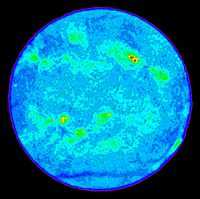Radiation astronomy/Radios/Lessons
< Radiation astronomy < Radios
Radio astronomy encompasses microwave astronomy, submillimeter astronomy, and those bands with longer wavelengths than microwaves. Radar astronomy is a technological use of microwaves to locate rocky objects.
There are 89 unique areas of the celestial sphere from which radio waves can irradiate the Earth. Ideally, there would be a first source from each of these areas.
As radio astronomy has been in use since the early twentieth century, a radio source has a good chance of also being a first source for any constellation.
Radio lessons
- First radio source in Canis Minor
- First radio source in Grus
- First radio source in Pisces
Microwave lessons
- First microwave source in Canis Major
- First microwave source in Cepheus
- First microwave source in Hercules
- First microwave source in Piscis Austrinus
Submillimeter lessons
- First submillimeter source in Carina
- First submillimeter source in Hydrus
- First submillimeter source in Reticulum
Research
Hypothesis:
- The first radio source was detected in a northern hemisphere constellation.
Control groups

The findings demonstrate a statistically systematic change from the status quo or the control group.
“In the design of experiments, treatments [or special properties or characteristics] are applied to [or observed in] experimental units in the treatment group(s).[1] In comparative experiments, members of the complementary group, the control group, receive either no treatment or a standard treatment.[2]"[3]
Proof of concept
Def. a “short and/or incomplete realization of a certain method or idea to demonstrate its feasibility"[4] is called a proof of concept.
Def. evidence that demonstrates that a concept is possible is called proof of concept.
The proof-of-concept structure consists of
- background,
- procedures,
- findings, and
- interpretation.[5]
See also
- Astronomy/Lessons
- First radio source
References
- ↑ Klaus Hinkelmann, Oscar Kempthorne (2008). Design and Analysis of Experiments, Volume I: Introduction to Experimental Design (2nd ed.). Wiley. ISBN 978-0-471-72756-9. http://books.google.com/?id=T3wWj2kVYZgC&printsec=frontcover.
- ↑ R. A. Bailey (2008). Design of comparative experiments. Cambridge University Press. ISBN 978-0-521-68357-9. http://www.cambridge.org/uk/catalogue/catalogue.asp?isbn=9780521683579.
- ↑ "Treatment and control groups, In: Wikipedia". San Francisco, California: Wikimedia Foundation, Inc. May 18, 2012. Retrieved 2012-05-31.
- ↑ "proof of concept, In: Wiktionary". San Francisco, California: Wikimedia Foundation, Inc. November 10, 2012. Retrieved 2013-01-13.
- ↑ Ginger Lehrman and Ian B Hogue, Sarah Palmer, Cheryl Jennings, Celsa A Spina, Ann Wiegand, Alan L Landay, Robert W Coombs, Douglas D Richman, John W Mellors, John M Coffin, Ronald J Bosch, David M Margolis (August 13, 2005). "Depletion of latent HIV-1 infection in vivo: a proof-of-concept study". Lancet 366 (9485): 549-55. doi:10.1016/S0140-6736(05)67098-5. http://www.ncbi.nlm.nih.gov/pmc/articles/PMC1894952/. Retrieved 2012-05-09.
External links
| |
Development status: this resource is experimental in nature. |
| |
Educational level: this is a research resource. |
| |
Subject classification: this is an astronomy resource. |